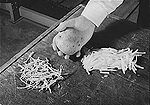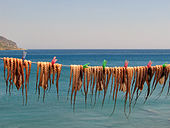Food drying
This article has multiple issues. Please help improve it or discuss these issues on the talk page. (Learn how and when to remove these template messages)
|


Food drying is a method of

Food types


Many different foods can be prepared by dehydration. Meat has held a historically significant role. For centuries, much of the European diet depended on dried
Dried fruits have been consumed historically due to their high sugar content and sweet taste, and a longer
may be transformed into different products that can either be eaten as they are, used in recipes, or rehydrated.Freeze-dried vegetables are often found in food for backpackers, hunters, and the military. Garlic and onion are often dried and stored with their stalks braided. Edible mushrooms are sometimes dried for preservation or to be used as seasonings.
Preparation
Home drying of vegetables, fruit and meat can be carried out with electrical dehydrators (household appliance) or by sun-drying or by wind.[5] Preservatives such as potassium metabisulfite, BHA, or BHT may be used, but are not required. However, dried products without these preservatives may require refrigeration or freezing to ensure safe storage for a long time.
Industrial food dehydration is often accomplished by
Hurdle technology is the combination of multiple food preservation methods. Hurdle technology uses low doses of multiple food preservation techniques in order to ensure food is not only safe but is desirable visually and texturally.
Packaging
Packaging ensures effective food preservation. Some methods of packaging that are beneficial to dehydrated food are vacuum sealed, inert gases, or gases that help regulate respiration, biological organisms, and growth of microorganisms.[citation needed]
Other methods

There are many different methods for drying,[7] each with its own advantages for particular applications. These include:
- Convection drying
- Bed dryers
- Drum drying
- Freeze Drying
- Microwave-vacuum drying[7]
- Shelf dryers
- Spray drying
- Infrared radiation drying[7]
- Combined thermal hybrid drying[8]
- Sunlight
- Commercial food dehydrators
- Household oven
See also
References
- ^ Grandidier (1899), p. 521
- ^ "Historical Origins of Food Preservation". Accessed June 2011.
- ISBN 9781420017373.
- ISBN 978-0805052473.
- ^ "Food Dehydrator reviews". www.dehydratorjudge.com. Retrieved 19 April 2016.
- PMID 33401820.
- ^ PMID 26108354.
- . Retrieved 2017-03-25.
